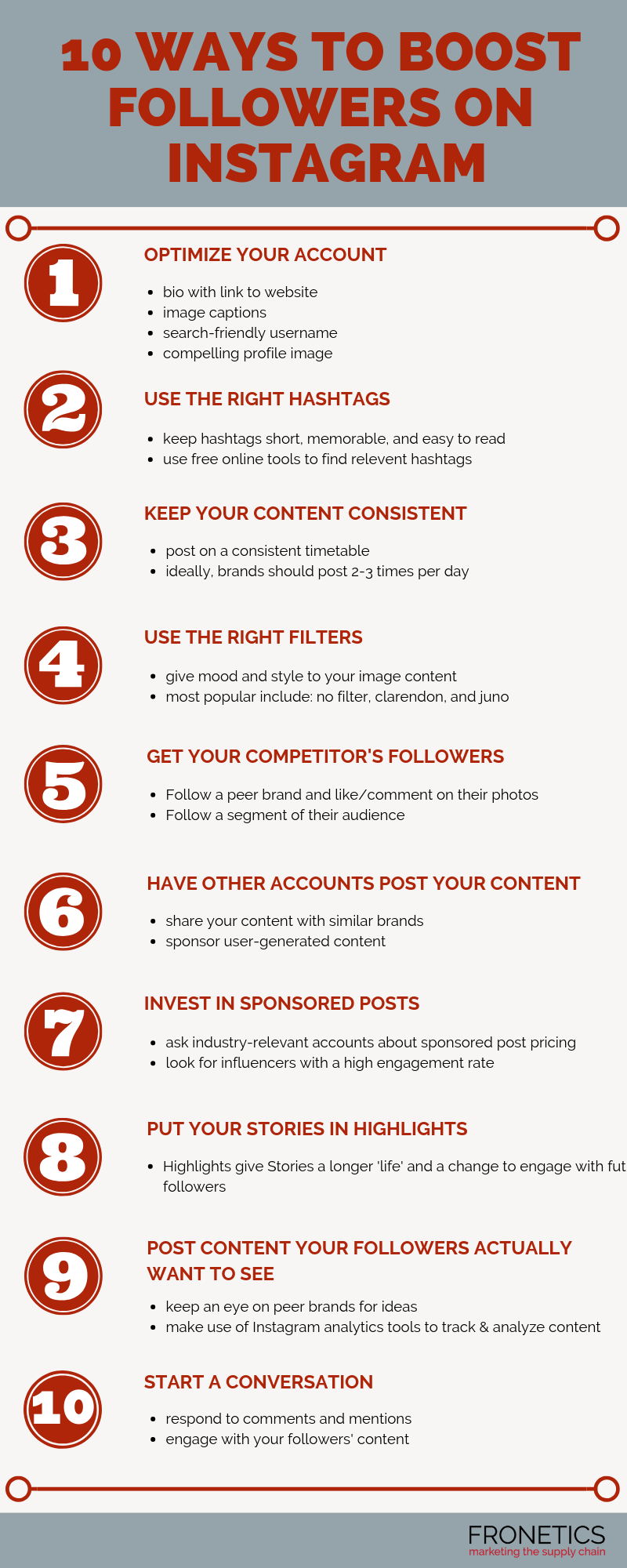
by Fronetics | Feb 7, 2019 | Blog, Content Marketing, Logistics, Marketing, Social Media, Supply Chain
Looking to boost followers on Instagram? These tips will help supply chain marketers grow their following, build brand awareness, and nurture a loyal audience base.
Highlights
- Instagram has over 500 million daily users.
- Fake accounts won’t help in the long run.
- Growing authentic followers requires commitment and strategy.
While it’s true that Facebook is a favorite for B2B marketing, don’t overlook Instagram. Over 500 million users browse the app daily — some of the most engaged audiences on the web. This is absolutely a powerful resource for supply chain marketers, and if you aren’t already, it’s time you start tapping into it.
But as with all social media platforms, there’s a right and a wrong way to go about using it. When it comes to Instagram, getting the most out of the platform has a lot to do with boosting followership.
Keep in mind that recent studies have shown that roughly 48 million Instagram users are fake. Inflating your audience with fake followers won’t serve you well.
Boosting engagement and growing your following takes time and strategy. The 10 tips in our infographic below will help you get the most out of Instagram, building an authentic, engaged audience.
10 tips to boost followers on Instagram

(Made with Canva)
1) Optimize your account
Before we get to anything fancy, take a step back and make sure your Instagram account is fully optimized. This means you need:
- a bio with a link to marketing or product pages related to a specific keyword or hashtag
- image captions, which can reference the link in your bio
- a search-friendly username
- a compelling profile image that reflects your brand
2) Use the right hashtags
One of the most effective ways to grow your Instagram following is to use hashtags effectively. Since Instagram gives users the ability to follow hashtags that interest them, and they function as links to other relevant content, choosing the right hashtags is the ideal way to reach and engage your target audience.
Keep an eye on accounts of peer brands to stay up to date with the best hashtags to be using. The most effective hashtags are short, memorable, and easy to read. You can also use a free online tool like InconoSquare or Websta to find relevant hashtags for the supply chain and logistics industries.
3) Keep your content consistent
Posting on a consistent timetable is crucial to maintaining an active following. Posting irregularly means you risk your followers forgetting about you. And posting all at once can annoy and drive followers away. Ideally, brands should post 2-3 times a day. For more, check out our guide to when to post on social media.
4) Use the right filters
We all know that playing with filters is fun. These lighting and color presets offered by Instagram have the potential to create mood and style in your image content. According to Iconosquare, these 10 filters are currently the most popular on Instagram. And it turns out that the filters you choose really do have an impact on engagement.
- Normal (No Filter)
- Clarendon
- Juno
- Lark
- Ludwig
- Gingham
- Valencia
- X-Pro II
- Lo-fi
- Amaro
5) Get your competitors’ followers
Maybe it sounds like a dirty trick, but hear us out! Users who have already shown an interest in similar brands to yours are an ideal audience base. Engaging with them is a great way to grow your own following. Identify a peer brand with a healthy Instagram following; follow a segment of their audience; and like or comment on their photos. Keep track of how many users follow your brand back.
6) Have other accounts post your content
Operating on the principle that followers of similar accounts to yours are an ideal audience base, getting these accounts to post your content is a great way to boost your followership. One way to do this is to sponsor user-generated content to get your brand in customers’ feeds. For example, hold a photo contest related to your brand, encouraging followers to post and caption your content.
7) Invest in sponsored posts and product reviews
Optimizing your account and following Instagram best practices will go a long way toward getting authentic followers. But to really boost your followers on Instagram, it pays to take advantage of influencer marketing on Instagram. Create a list of large accounts in your industry, follow them, reach out to their marketing team, and ask about sponsored post pricing. Be on the lookout for influencers with a high engagement rate relative to number of followers.
8) Put your Stories in Highlights
In addition to its Stories feature, Instagram now lets users create a featured group of “Highlights” in various categories on their profile. Stories have only a 24-hour lifespan, so featuring your most effective Stories clips in Highlights gives them a second life and a chance to engage future followers. One of the best features of Stories and Highlights is that they allow brands to view and analyze how users have viewed and interacted with their content.
9) Post content your followers actually want to see
This one may sound painfully obvious, but it’s harder than it looks. Because brands need to publish content consistently to maintain an active Instagram following, it can be extremely difficult to generate fresh, interesting content consistently. There’s no easy trick to this one. Keep an eye on peer brands, and make use of Instagram analytics tools to track, analyze, and benchmark Instagram content.
10) Start a conversation
It’s easy to forget that the fundamental benefit of social media is that it’s social. Users want to be part of a conversation. Encourage your followers to interact with you on all your social media platforms, including Instagram. This means responding to comments and brand mentions, as well as engaging with your followers’ content.
Final thoughts
Instagram is an extremely effective tool for supply chain marketers. These 10 tips to boost followers on Instagram will help you create and nurture a loyal, engaged audience base. In turn, an effective Instagram presence has the potential to grow brand awareness, improve your reputation, and generate qualified leads.
Related posts:


by Fronetics | Feb 6, 2019 | Blog
Digital marketing has become essential to creating brand awareness, educating audiences and building credibility with customers. Here are the latest trends for 2019.
Highlights:
- Digital marketing has become essential to creating brand awareness, educating audiences and building credibility and trust with customers.
- Video is currently the most popular form of content being consumed online today.
- Peers and colleagues are the third most influential source of information for business to business (B2B) purchasing, right behind online searches and your website.
Video transcript:
Hi I’m Stacia Pathiakis. I’m an account manager at Fronetics and today I’ll going to be talking to you about six trends in digital marketing for the supply chain in 2019.
Digital marketing has become essential for creating brand awareness, educating audiences and building trust and credibility with your customers. Supply chain and logistics companies increasingly see the value in digital marketing. They’re increasing their budgets and it’s important to understand what the trends are for the upcoming year.
Here are six trends to consider when planning your 2019 strategy.
First, video. Video is currently the most popular form of content being consumed online today, and video marketing will continue to add substantial value in the upcoming year. Use video to teach your audience something that is worthwhile for them to know.
- Chatbots. Chatbots are automated messaging apps that simulate human conversation. They’ve become more popular in the past year than social networks.
- Voice search. Voice search is becoming an increasingly prevalent. It’s a means for people to search for the content they’re looking for using voice recognition. A good content marketing strategy should consider how your customers will be using voice search for information about in your industry.
Next is long-form content. Long form content includes such things as white papers, case studies, and longer form blog posts. Many industries, including supply chain and logistics industries, are saturated with short form content. Long form content provides a means of getting more in-depth information to your customers.
- Brand ambassadors. Peers and colleagues are the third most influential source of information for business to business (B2B) purchasing. And there’s nothing more credible than a friend who speaks highly of their company’s services and products.
- Market influencers. Market influencers is a form of marketing that focuses on individuals rather than the market as a whole. Basically, marketers identify individuals who would have influence over a larger group and target them specifically in their digital marketing campaign.
The beginning of the year is a great time to review your marketing strategy to make any changes for the upcoming year. For more tips on boosting your digital marketing strategy in 2019, visit us at fronetics.com.
Related posts:


by Fronetics | Feb 5, 2019 | Blog, Content Marketing, Logistics, Marketing, Supply Chain
Our readers voted Cerasis, Women in Trucking, and Hollingsworth as the top 3 logistics and supply chain blogs of 2019.
You voted, and the results are in! Cerasis is your number one favorite blog of the year, with Women in Trucking and Hollingsworth coming in second and third.
We love hearing what blogs you enjoy reading and find valuable. There are lots of great industry options, so we know it’s not easy to narrow down your favorites. We had lots of great responses, but only Women in Trucking held its spot on our list of the top logistics and supply blogs from 2018 and 2017.
Aside from Women in Trucking, what did remain consistent from previous years is the quality of the content and the consistency of posting by the three winners. These key components have remained invaluable across all successful logistics and supply chain blogs.
Here are the top 3 logistics and supply chain blogs of 2019.
1. Cerasis
As a third-party logistics company, Cerasis works to decrease freight management inefficiencies and to provide maximum hard and soft cost savings for their customers in the process of shipping LTL (less than truckload) or truckload freight and small package freight. The blog focuses on transportation industry trends and logistics solutions with relatable topics and insightful content.
2. Ellen’s Blog for Women in Trucking
The Women in Trucking Association is a non-profit organization focused on encouraging the employment of women in the trucking industry, promoting their accomplishments, and minimizing obstacles. President and CEO Ellen Voie’s blog offers thought-provoking insight on topics from best practices to becoming a thought leader in a mostly male dominated industry. Her years of experience and passion for advancing women’s positions within the trucking industry make her blog invaluable to readers. For the third year in a row, this blog has been one of our readers top favorites due to the relatable topics and insightful content, such as family problems stemming from job-related realities and assimilating to trucking culture.
3. Hollingsworth
Utilizing best-in-class warehouse management technology, Hollingsworth offers complete, real-time visibility of the supply chain. The blog focuses on topics ranging from complex order fulfillment strategies to best practices for optimizing supply chain management. Industry tips, new technologies, and the latest strategies are just some of the topics covered in the articles.
Runner up: Argentus
Argentus, a leading supply chain recruiting firm, pulls collective expertise to good use to ensure clients are provided with the best talent available at all levels. Argentus’ blog is a go-to source for posts on talent, leadership and supply chain employment trends. Whether you’re looking for tips on hiring industry leaders, retaining your top talent, or promoting professional development, Argentus’ blog has you covered. It also regularly features guest bloggers from verticals throughout the supply chain.
Related posts:


by Fronetics | Jan 31, 2019 | Blog, Content Marketing, Current Events, Marketing, Social Media
Also, this month in social media news: Instagram allows posts to multiple accounts; Snapchat shares research on social media use; and YouTube adds new swipe-to-view option.
Highlights
- Facebook and YouTube are making changes that reflect a shift toward the Stories format.
- Snapchat releases research revealing that users seek different types of content on different social media platforms.
- Twitter is considering a big update to its conversational features designed to boost user engagement.
The new year is off and running in the social media world. As social media platforms vie to keep up with user behavior, we’re seeing a broad industry shift in favor of the “Stories” format. Facebook is attempting to ramp up the popularity of its Stories feature by giving users more options for direct response, while YouTube is introducing a swipe option, reflecting the growing preference for this kind of interface.
Businesses should take heed to the changes this month. The opportunity for CTA stickers in Facebook Stories — as well as Twitter’s plans for new conversational features and Instagram’s introduction of a feature allowing users to post across accounts at the same time — have important implications for how B2B businesses market themselves on social media. Additionally, Snapchat has released the results of a study examining how and why people use various social media platforms.
Here’s your social media news for January 2019.
Facebook Adds Call-to-Action Stickers for Page Stories
As Facebook continues to work toward making its version of Stories a success, the social media titan is testing a new set of Call-to-Action (CTA) stickers for Pages. The stickers let businesses on Facebook use Stories more effectively via direct-response tools.
The new buttons echo the CTA options already available to Pages in their header. Options include inviting users to “Shop Now,” “Book,” or “Get Directions” directly from within Stories.
Why does this matter for B2B businesses? This new feature brings direct action to where Facebook is pushing users to spend more and more time — Stories.
Twitter Releases Detailed Plans for Beta Testing of New Conversational Features
Twitter is looking to evolve its platform in line with usage trends, announcing the creation of a new beta program to test its conversational options. According to TechCrunch, Twitter will soon launch the beta program with a select group of users. Features to be tested include color-coded responses, algorithmically sorted replies, and status updates.
If the beta testing is successful and Twitter adopts the changes, expect to see a big impact on platform use. For example, color-coded replies would corollate with your connections, making them easier to locate within extensive threads. Algorithm searching would also assist with keeping users up to date with the most personally relevant parts of any discussion — all with the goal of boosting engagement.
Instagram Now Lets You Post to Multiple Accounts at Once
Earlier this month, Social Media Today and TechCrunch reported that Instagram is rolling out a feature allowing users to post a single update across multiple profiles at the same time. For social media managers responsible for maintaining several accounts, this is big news.
[bctt tweet=” Instagram is rolling out a feature allowing users to post a single update across multiple profiles at the same time. For social media managers responsible for maintaining several accounts, this is big news.” username=”Fronetics”]
It’s now easy to post content to all accounts at once. But the question remains: is this good news for your audience? Of course, every case is different, but it’s yet to be determined if this ease of posting identical content across multiple platforms will broaden audience engagement or backfire, causing users to get bored and tune out your content all together.
Snapchat Shares New Research on How and Why People Use Different Social Media Platforms
Partnering with Murphy Research, Snapchat Business conducted a study of more than 1,000 of its users between the ages of 13 and 44. The goal was to gain insight into the social media apps they use, why they spend time on each, and how each makes them feel.
The research revealed three key insights:
- The apps people use can impact their moods.
- There’s a reason users tap on each app.
- And there’s a time and place for each app in this space.
What does this mean for B2B users? Being aware of the various platforms people use to find a specific type of content, for example, can help shape content creation and sharing.
YouTube Adds a New Option to Swipe to View the Next Video
As if it weren’t easy enough to fall down a YouTube rabbit hole. This month, the video giant is rolling out a new option that gives users the option to swipe left to view the next video or right to go back to the previous. Users can also get a “sneak peek” of the next or previous video by partially swiping. Currently, the update is only available to iOS users and is in line with a broader industry trend toward the swipeable Stories format.
Related posts:


by Jennifer Hart Yim | Jan 30, 2019 | Blog, Content Marketing, Current Events, Logistics, Marketing, Supply Chain, Talent
Supply Chain skills have never been in more demand and the work has never been more interesting. Here’s a look at the best degree for supply chain management.
Highlights:
- Today’s supply chain professionals need to be well-versed in data analysis, presentation skills, negotiation skills, project management skills.
- Individual career objectives and educational options can help determine the best degree.
This guest post comes to us from Argentus Supply Chain Recruiting, a boutique recruitment firm specializing in Supply Chain Management and Procurement.
Supply Chain Management was seen as a back-office profession. People tended to rise from shop floors and warehouses into management roles and eventually – for the most high-performing individuals – Senior Director and C-Suite positions. It’s always been one of those fields that people “fall into.” Once they found themselves in a Supply Chain or Procurement job, people tended to look around and see how important it was to the business. They’d experience the fast pace, see the immense ten-dimensional puzzle involved in getting a product to market, the global scope, and be hooked.
It used to be a truism that no teenager decides that they want to get into Supply Chain, even those who had their sights set on the corporate world and not other paths like medicine or law. Supply Chain used to be the kid brother to other, more “glamorous” corporate functions like marketing and finance: misunderstood, transactional, and frankly thankless work.
No longer.
In 2018, Supply Chain Management is a key market differentiator for companies in industries as diverse as consumer goods, retail, pharmaceutical, manufacturing, you name it. Supply Chain skills have never been in more demand in the corporate word, and the work has never been more interesting. Many of the top companies in the world are waging a constant war for Supply Chain talent, with baby boomers retiring and strong economic growth driving demand. Young people are starting to wake up to the huge amount of opportunity in the field.
[bctt tweet=”Today’s Supply Chain professionals need to be well-versed in data analysis, presentation skills, negotiation skills, project management skills, as well as the know-it-when-you-see it overall skill of “business acumen.”” username=”Fronetics”]
At the same time, companies are increasing educational requirements, which makes sense: today’s Supply Chain professionals need to be well-versed in data analysis, presentation skills, negotiation skills, project management skills, as well as the know-it-when-you-see it overall skill of “business acumen.” In our recruitment practice, we’re noticing that more clients are requiring a university degree as a hard-and-fast requirement for jobs.
The requirement often ends there. “A degree.” Which means that there are lots of educational avenues aspiring Supply Chain professionals can take to set themselves apart from the competition. But it can be daunting: should you do an Engineering degree with a focus on Industrial Engineering? Should you do a business degree? A liberal arts degree and then an MBA? Or should you forgo a formal degree and pursue certifications like CSCMP and APICS from industry associations?
It depends. It’s hard to arrive at a definitive answer. Why is that?
- Individual career objectives vary. For example, someone who wants to pursue a career in sourcing and Procurement will probably be better served by a business degree than an engineering degree. And someone who’s interested in Production Planning, Supply Planning, and/or Demand Planning is probably best served by a STEM degree that features a lot of quantitative analysis.
- Educational options vary. More schools are offering Supply Chain specialties as part of MBA programs, as well as at the undergrad and college levels. More traditional programs (engineering, business, etc.) are taking steps to prepare students for careers in Supply Chain Management. But options for programs vary based on geography and the grades that any one candidate brings to the table.
That said, we still think it’s worthwhile to give some tips for people exploring their education options in the field. So we put the question to our network of established Supply Chain professionals to see what they had to say.
Here are some of the more insightful responses:
“Engineering degree with focus in database structures and statistics can equip one with the required skills for this domain. Presently all SCM jobs require one to be able to work with ERP systems so it is nice to have understanding about the underlying concepts.”
“The easiest that i can think of is Industrial Engineering which is a mix of Engineering/Mgt/commercial/statistics subjects. My degree in IE was a sound base to launch me into a SC/Logistics career. Then top it off with a certification after gaining some work experience. Certifications without some work exposure may turn to be useless. Certifications should be a source of validation of what you know in the discipline. I do hear there are schools/community colleges these days offering SC/Logistics as a degree. In all, any course that exposes and builds a person’s critical thinking skills is ok to get into supply chain.”
“Best degree would be to start working in a warehouse. Try some scheduling work also if you can. For all the value that a degree gives you, nothing beats knowing how goods flow and how truck drivers get stuff from point A to B. Do this for a year, then worry about which degree to get.”
“1) Chemical/Industrial/Mechanical Engineering 2) Economics 3) Business/Commerce with a major in finance 4) a solid liberal arts education from a university that will propel you into a top business school.”
“Engineering or Business provide a great foundation for logical, innovative and strategic thinking.”
Hopefully the above comments can help offer some guidance to anyone who’s interested in embarking on Supply Chain Management as a career path. There are lots of paths to go down. But whether you choose the university, college or certifications route, it’s pretty undeniable that more education is never a bad thing.
Related posts:


by Fronetics | Jan 29, 2019 | Blog, Content Marketing, Logistics, Marketing, Social Media, Supply Chain
Knowing the right video distribution channels can go a long way toward driving traffic and getting your content to your target audience.
Highlights:
- An effective video distribution strategy is key to success.
- Choose video distribution channels that match your marketing goals.
- Paid ads can give video an extra boost.
Video transcript:
I’m Christy Lemire, the Director of Video Marketing here at Fronetics. Today we’re going to be talking about the four best distribution platforms for video.
Here are the four best platforms for distributing your marketing videos.
1. Your network
Don’t underestimate the power of your own existing network. Send your videos, via email, to your primary contacts and everyone in your current database.
2. Social media
Platforms like Facebook, Instagram, Twitter, Snapchat, and of course YouTube are great to reach your target audience. Of course within the category of social media, you want to consider what platforms suit your content best. YouTube is a great place to start, but there are also many industry specific online forums and social groups that can benefit you as well.
3. Blogs
Promote your video on your own blog to reach your followers and boost your SEO. It’s also a good idea to distribute your video on other industry specific blogs to overlap your target audience.
4. Paid ads
While the first three channels of distribution we discussed are organic, sometimes it is well worth it to use paid ads to give your content a significant boost, such as Google Adwords and AdSense.
Bottom line is using the right distribution channels helps you get the most out of your video marketing efforts. For more information about video marketing, visit Fronetics.com.
Related posts:












